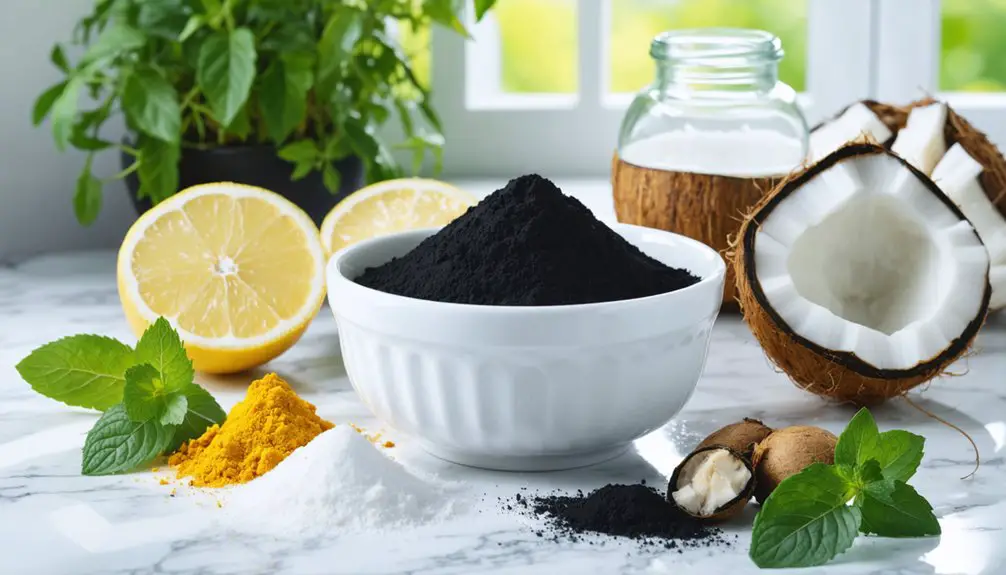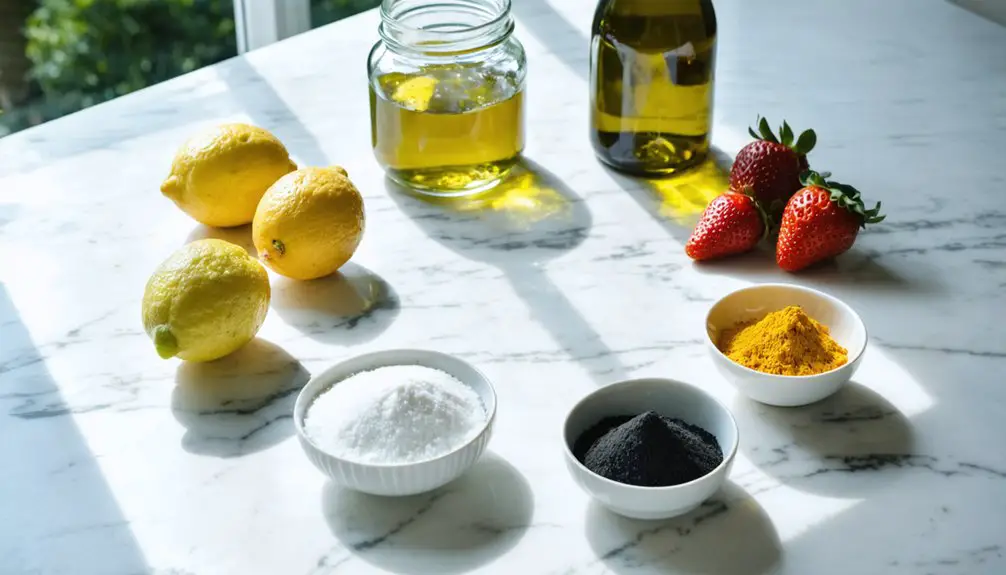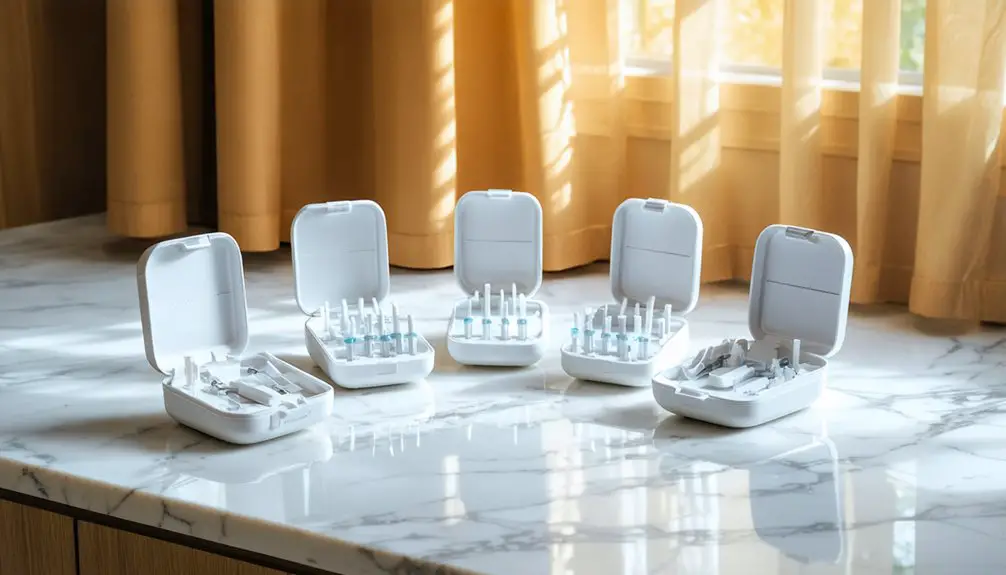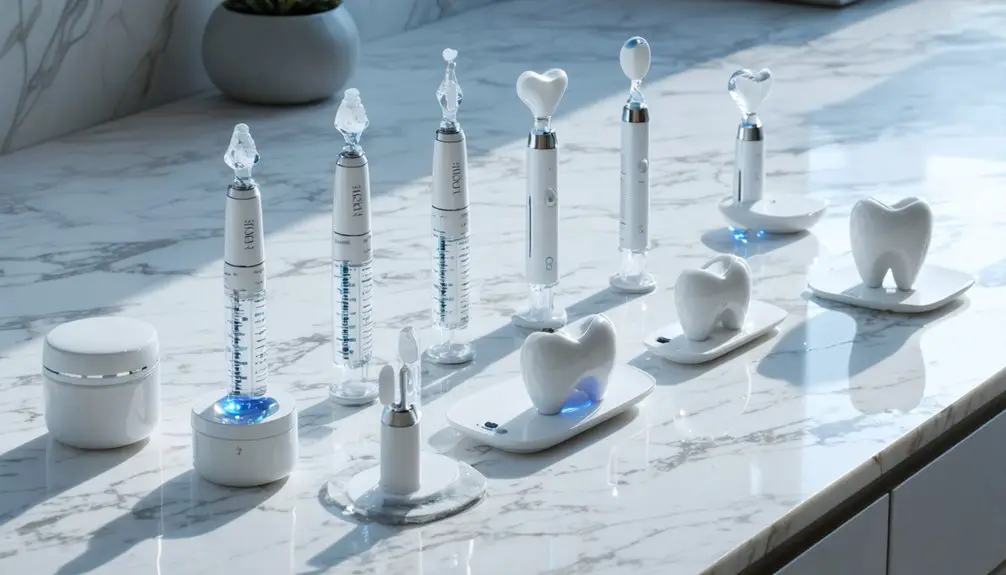You can safely whiten your teeth at home using several natural methods that protect your enamel. Common approaches include mixing baking soda with hydrogen peroxide, practicing oil pulling with coconut oil, or applying a strawberry-baking soda paste. While natural whitening takes longer than chemical treatments, it’s gentler on your teeth and more cost-effective. For best results, limit treatments to once or twice weekly and maintain good oral hygiene. Let’s explore these proven techniques in detail.
Key Takeaways
- Mix baking soda with hydrogen peroxide to create a whitening paste, applying once weekly with a soft-bristled toothbrush.
- Practice oil pulling by swishing coconut or sesame oil for 15-20 minutes daily to reduce bacteria and brighten teeth.
- Combine mashed strawberries with baking soda to create a natural whitening paste that breaks down surface stains.
- Use gentle brushing techniques with fluoride toothpaste and drink water throughout the day to maintain white teeth.
- Consume calcium-rich foods like dairy and leafy greens to strengthen enamel and support natural whitening efforts.
Why Natural Teeth Whitening Methods Matter
While chemical teeth whitening treatments remain popular, natural methods offer compelling advantages for those seeking a gentler approach to achieving a brighter smile.
Natural whitening techniques prioritize enamel preservation by avoiding harsh chemicals that can erode your tooth structure or create unwanted porosity. You’ll find these methods typically rely on mild abrasives or natural compounds that pose less risk to your dental health. Before starting any natural whitening regimen, consulting a dentist can help ensure the methods are appropriate for your specific dental needs.
The benefits extend beyond enamel protection to support overall gum health. Unlike aggressive chemical treatments that may cause irritation or burns, natural approaches work harmoniously with your oral tissues.
You’re also gaining holistic advantages through increased saliva production and improved oral microbiome balance. These methods often integrate seamlessly into your existing dental care routine while being both cost-effective and accessible for regular maintenance. Incorporating crunchy fruits and vegetables into your diet can naturally scrub away surface stains while promoting better oral health.
The Baking Soda and Hydrogen Peroxide Method
Since baking soda and hydrogen peroxide offer complementary whitening mechanisms, combining them creates a potent natural teeth-whitening solution.
To harness both baking soda benefits and hydrogen peroxide effectiveness, mix two parts baking soda with one part 3% hydrogen peroxide until you’ve created a thick paste. Apply this mixture using a soft-bristled toothbrush and gentle circular motions for two minutes.
Mix two parts baking soda with one part hydrogen peroxide, creating a paste. Brush gently in circles for two minutes.
You’ll want to limit this treatment to once weekly to protect your enamel. The baking soda’s mild abrasiveness removes surface stains while its alkalinity fights harmful bacteria. Massaging the gums and teeth is more effective than aggressive scrubbing. This affordable treatment delivers quick results compared to many commercial whitening products.
Meanwhile, hydrogen peroxide penetrates deeper, oxidizing stubborn stains through its bleaching action. After use, rinse thoroughly and follow with fluoride toothpaste.
If you experience sensitivity, discontinue use immediately and consult your dentist.
Oil Pulling: Ancient Wisdom for Whiter Teeth
As an ancient Ayurvedic practice dating back over 3,000 years, oil pulling has gained renewed attention in modern wellness circles for its potential teeth-whitening properties.
While scientific evidence remains limited, studies suggest this traditional method can reduce oral bacteria when used as a complement to your regular dental hygiene routine. The American Dental Association does not officially endorse oil pulling as a substitute for proven dental care methods. You’ll need to swish a tablespoon of coconut or sesame oil in your mouth for 15-20 minutes daily to potentially experience oil pulling benefits. Research shows that plaque reduction may be comparable to using chlorhexidine mouthwash.
- Use only food-grade oils like coconut, sesame, or sunflower
- Swish gently to avoid jaw fatigue
- Don’t swallow the oil – it may contain trapped bacteria
- Spit into trash rather than sink to avoid clogged pipes
- Continue your regular brushing and flossing routine
Strawberry and Baking Soda: Nature’s Tooth Brightener
Looking for a gentler alternative to commercial whitening products, many people have turned to the natural combination of strawberries and baking soda for teeth whitening.
The strawberry benefits stem from its malic acid content, which helps break down surface stains, while baking soda effectiveness comes from its mild abrasive properties that remove plaque and debris.
Recent research shows this mixture only provides temporary brightening by removing surface debris rather than deeply whitening teeth.
To try this method, you’ll want to mash fresh strawberries with a small amount of baking soda to create a paste.
Apply it to your teeth for just a few minutes, then rinse thoroughly.
While this combination can provide mild whitening results, it’s important to use it sparingly – no more than once or twice weekly. Since this method uses low acid concentrations, results may not be as dramatic as professional treatments.
Always follow up with regular toothpaste to neutralize acids and protect your enamel.
Using Apple Cider Vinegar for a Brighter Smile
While apple cider vinegar has gained popularity as a natural teeth whitening solution, dental professionals urge caution due to its potentially harmful effects on tooth enamel.
Though ACV benefits include antimicrobial properties and mild bleaching effects from acetic acid, the risks of enamel erosion often outweigh these advantages. Research shows ACV has a pH of 2.5-3.0, making it highly acidic and potentially damaging to teeth. Initial whitening results from ACV can be deeply misleading since long-term use leads to yellowing teeth.
- Dilute 1-2 teaspoons of ACV with water before application
- Apply the mixture to teeth for only 1-2 minutes
- Rinse thoroughly with water immediately after use
- Wait 60 minutes before brushing to protect softened enamel
- Limit usage frequency to prevent permanent tooth damage
If you’re considering ACV for teeth whitening, understand that safer alternatives exist.
Professional whitening treatments and specialized toothpaste offer more reliable results without compromising your dental health through enamel damage.
Activated Charcoal: A Modern Natural Alternative
Activated charcoal has emerged as a trendy natural teeth whitening solution, but scientific evidence reveals significant limitations and potential risks.
While it may help remove surface stains, it’s less effective than traditional whitening methods and doesn’t address deeper discoloration beneath the enamel.
You’ll want to exercise caution, as activated charcoal‘s abrasive nature can damage your tooth enamel, leading to sensitivity and increased decay risk.
If you have dental restorations, the charcoal particles might accumulate in crevices and margins, causing unsightly gray or black discoloration.
Most charcoal toothpastes also lack fluoride, compromising your overall dental health.
For safer and more reliable results, consider professional cleaning and whitening treatments.
If you choose to use charcoal products, limit their use and consult your dentist first.
Safety Tips and Best Practices for Natural Whitening

To protect your tooth enamel while naturally whitening, you’ll need to avoid harsh abrasives and acidic ingredients that can cause irreversible damage.
You should always test new whitening methods on a small area first to check for sensitivity and follow the recommended frequency of treatments rather than overusing products in pursuit of faster results.
Natural whitening requires patience and moderation – limit treatments to 1-2 times per week and stop immediately if you experience increased tooth sensitivity or gum irritation.
Protect Your Tooth Enamel
Since tooth enamel serves as your teeth’s protective shield, preserving its integrity remains essential during any whitening process.
Your enamel’s health directly impacts both the success of whitening treatments and your long-term oral health. Focus on enamel protection and remineralization techniques to maintain strong, naturally white teeth.
- Choose calcium-rich foods like dairy products and leafy greens to support enamel remineralization
- Wait 30 minutes after consuming acidic foods before brushing to prevent mechanical erosion
- Use fluoride toothpaste and gentle brushing techniques to strengthen enamel
- Drink water throughout the day to neutralize acids and wash away staining compounds
- Incorporate crunchy fruits and vegetables into your diet to naturally clean teeth while stimulating protective saliva production
Follow Recommended Treatment Frequency
While protecting your enamel forms the foundation of tooth whitening success, following proper treatment intervals guarantees both safety and ideal results.
When using natural whitening agents like baking soda or activated charcoal, limit applications to once or twice weekly to prevent enamel erosion. Your whitening schedules should include adequate rest periods between treatments, allowing your teeth to remineralize and recover.
If you’re experiencing sensitivity, extend the time between treatments and consider consulting your dentist for personalized guidance.
You’ll need to adjust your treatment intervals based on lifestyle factors – if you regularly consume staining beverages or smoke, you may require more frequent touch-ups.
Remember that daily use of whitening toothpaste can help maintain results between primary treatments while keeping your whitening routine safe and effective.
Test For Sensitivity First
Before starting any natural teeth whitening regimen, conducting a sensitivity test could save you from potential pain and complications. Proper sensitivity testing helps protect your enamel health and guarantees you choose the right whitening method for your teeth.
Apply a small amount of your chosen natural whitening agent to one tooth surface and monitor for reactions over 24-48 hours.
- Start with mild agents like baking soda or strawberry paste for initial testing
- Watch for sharp pain, persistent discomfort, or temperature sensitivity
- Monitor your gums for redness or irritation during the test period
- Document your baseline tooth color and sensitivity levels
- Use sensitivity-friendly ingredients like aloe vera or coconut oil if you experience discomfort
If you notice any adverse reactions, consult a dental professional before proceeding with full treatment.
Frequently Asked Questions
How Long Does It Take to See Results Using Natural Teeth Whitening Methods?
You’ll notice initial whitening effectiveness within 2-7 days, with full results timeline spanning 2-4 weeks of consistent treatment. Your original tooth color and chosen natural method affect timing markedly.
Can These Natural Whitening Methods Remove Deep, Long-Term Stains From Smoking?
Natural remedies won’t effectively remove your deep smoking stains. While they may help with surface discoloration, long-term smoking effects require professional dental treatments for significant stain removal and whitening results.
Is It Safe to Combine Different Natural Whitening Methods Simultaneously?
You shouldn’t combine natural whitening methods simultaneously. Method effectiveness isn’t enhanced by mixing, and you’ll risk serious safety concerns like enamel damage, gum irritation, and tooth sensitivity from overlapping treatments.
Should I Brush My Teeth Before or After Using Natural Whitening Treatments?
Brush before treatments as pre-treatment care, using gentle brushing techniques to remove surface debris. Afterward, simply rinse your mouth unless specifically directed otherwise by your treatment protocol or dental professional.
Will Natural Whitening Methods Work on Dental Crowns or Veneers?
Like throwing paint at marble, natural whitening won’t change your crowns or veneers’ color. Focus on crown maintenance and veneer care through proper brushing and professional cleaning to preserve their appearance.
References
- https://www.hyannisdental.com/blog/brighten-your-smile-naturally-6-simple-ways-to-whiten-teeth-at-home/
- https://www.berkeleyhillsdentist.com/brighten-your-smile-naturally-berkeley-home-remedies-for-teeth-whitening/
- https://www.healthline.com/nutrition/whiten-teeth-naturally
- https://www.lwdentist.com/diy-teeth-whitening-what-works-and-what-to-avoid/
- https://cheslynhaydental.co.uk/do-these-8-popular-home-teeth-whitening-methods-work/
- https://pmc.ncbi.nlm.nih.gov/articles/PMC10024105/
- https://www.riversidecenterforestheticdentistry.com/dental-services/blog/do-natural-teeth-whitening-remedies-really-work
- https://chestnutdental.com/blog/are-natural-teeth-whitening-methods-safe-and-effective/
- https://www.dentistryformidtown.com/blog/natural-teeth-whitening-remedies-separating-fact-from-fiction/
- https://pmc.ncbi.nlm.nih.gov/articles/PMC4058574/



